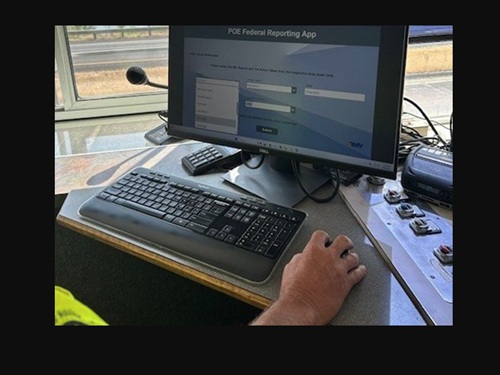The Idaho Transportation Department (ITD) recently detailed how new technologies – from electronic screening to tire monitoring – has improved Ports of Entry or POE operations statewide.
[Above photo by ITD]
The agency noted that its POE staff ensures that commercial motor vehicles or CMVs are safe and comply with federal and state regulations – with staffers managing hundreds, often thousands, of vehicle inspections, registrations, and permit requests daily.

Given the high volume of commercial traffic on Idaho’s roads – totaling millions of vehicles annually – the ITD said POEs are integral “focal points” for maintaining smooth, secure, and safe travel for motorists and CMVs alike.
In addition to visual inspections for damage or missing CMV components – such as safety markers, tire lug nuts, mirrors, placards, exhaust systems, or mud flaps – ITD staff use advanced electronic screening and weigh-in-motion (WIM) technologies to enhance the efficiency and accuracy of that safety work.
The agency noted that electronic WIM systems effectively identify vehicles that are potentially overweight, over-length, or over-height – streamlining the inspection process.
[Editor’s note: A recent episode of ‘On the Road with NYSDOT’ took a behind-the-scenes look at the truck and bus inspection efforts of the New York State Department of Transportation.]
A key component of ITD’s electronic screening process is the Commercial Vehicle Information Exchange Window or CVIEW. This interface enables inspectors to access comprehensive vehicle data—such as registration details, safety records, permits, and driver information—to determine whether a more thorough inspection is necessary.
Complementing that system is ITD’s tire anomaly detection system – installed in 2024 recently recognized with an American Association of Motor Vehicle Administrators award – which helps identify tire issues such as worn tread, punctures, insufficient pressure, or mismatched sizes by axle.
This technology not only facilitates the identification of suspect vehicles for further inspection, but also allows compliant vehicles to bypass the port, ITD said – improving traffic flow and reducing operational costs.
While these technological tools provide powerful data-driven insights, it’s important to recognize the continued value of traditional visual inspections, noted Frank DeCarvalho, the agency’s new POE program manager, in a statement.
These in-person checks remain a critical component of the inspection process, offering opportunities not only to identify issues that may not be captured electronically but also to engage directly with drivers.
“I am highly impressed with our inspectors and their effective use of electronic-screening technology to manage vehicle flow through our busy ports,” DeCarvalho noted. “The training they receive and their dedication are essential to fulfilling our mission while providing excellent customer service.”
 States
States
Alaska DOT&PF Highlights Benefits of New FAA Guidance
August 15, 2025 States
States

